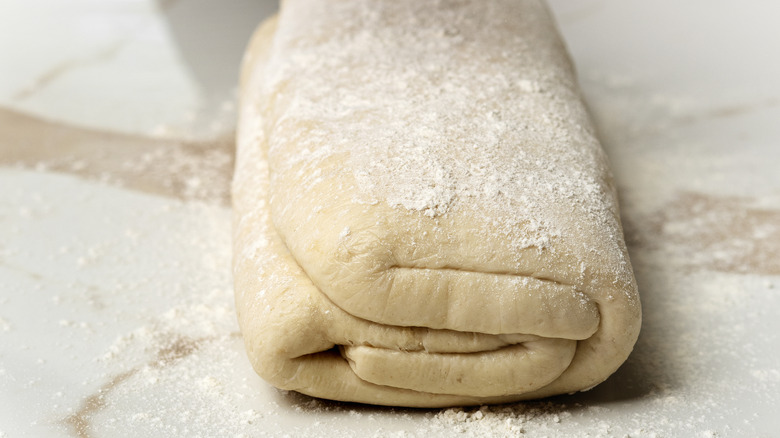For Easier Homemade Croissants, Try Using Softened Butter
Croissants are a quintessential French treat. Buttery, flaky, and simply divine, the rich, delectable French pastry named for its crescent shape has been pleasing even the most discerning of palates since the early 13th century. Beyond almond, chocolate, or ham and cheese, there are so many foods you can stuff inside a croissant, and the snack's popularity has even inspired highly sought-after hybrid pastries, such as chef Dominique Ansel's cronut, a luxurious blend of the croissant and the doughnut. However, no one ever said making your own croissants at home was easy.
The croissant-making process, requiring refined techniques and a lot of time and patience, is fairly labor-intensive and temperamental at the very least. But the good news is that modern bakers have developed some infallible methods for making the perfect homemade croissant easier to achieve — for example, softening your butter before laminating your dough. It turns out that the pivotal step of softening your butter to a spreadable consistency instead of the traditional move of keeping it cold and solid completely changes the game, simplifying the dough folding process, limiting the risk of your dough tearing, and helping you master the technique of creating those signature flaky, light layers so easily you might just want to convert your kitchen into a bakery.
Softening your butter for your homemade croissants
Butter is an essential ingredient in croissants, but there are many different types of butter, and not all of it is created equal. For flaky, delectably tender, airy croissants, using a quality European-style butter — which has 82 to 85% milk fat (nothing below 80%), less water content, and can be found in specialty grocery stores — is central to success. You can use regular American butter, but your results won't be nearly as rich or decadent. Whichever butter you use, though, softening it before laminating your dough is the real money move.
Softened butter will be much easier to roll out, which will in turn make laminating your dough easier and avoid compromising rips. You want to soften it only until it's pliable — it should retain a bit of its firmness, but you should be able to bend your butter without it breaking. As an alternative to setting it out at room temperature, you can add a tablespoon of flour to your butter and mix with your stand mixer until it reaches the desired softness, then use a spatula to spread it evenly across the croissant dough (much like spreading cinnamon roll filling). Then you'll want to freeze your dough for between six and 30 minutes between each fold, long enough for your butter to chill but not completely harden. Instead of the traditional butter block method, which requires laborious rolling of cold butter, this will allow you to make delectable croissants with ease.
Other tips for making your dough laminating process easier
In addition to softening your butter, you'll want to be mindful of how much flour you use during the dough laminating process. If you use too much, it could make it more difficult for your croissant layers to stick to each other. Additionally, be sure to brush off any excess flour, which could affect the adherence of your dough layers.
For perfect homemade croissants, even chocolate-filled candy bar croissants, you'll also want to make sure your oven temperature is nice and hot — they bake better faster, so make sure your oven has reached the appropriate temperature — about 375 degrees Fahrenheit. If you bake your croissants at a lower temperature, they will take longer to rise, and they will be too dry.
Don't forget to use an easy touch when handling your croissant dough — and even when brushing on your egg wash — so you can preserve those flaky layers. If you follow these steps to simplify your croissant-making process, there's no reason you shouldn't be able to make a batch of quality croissants at home.


